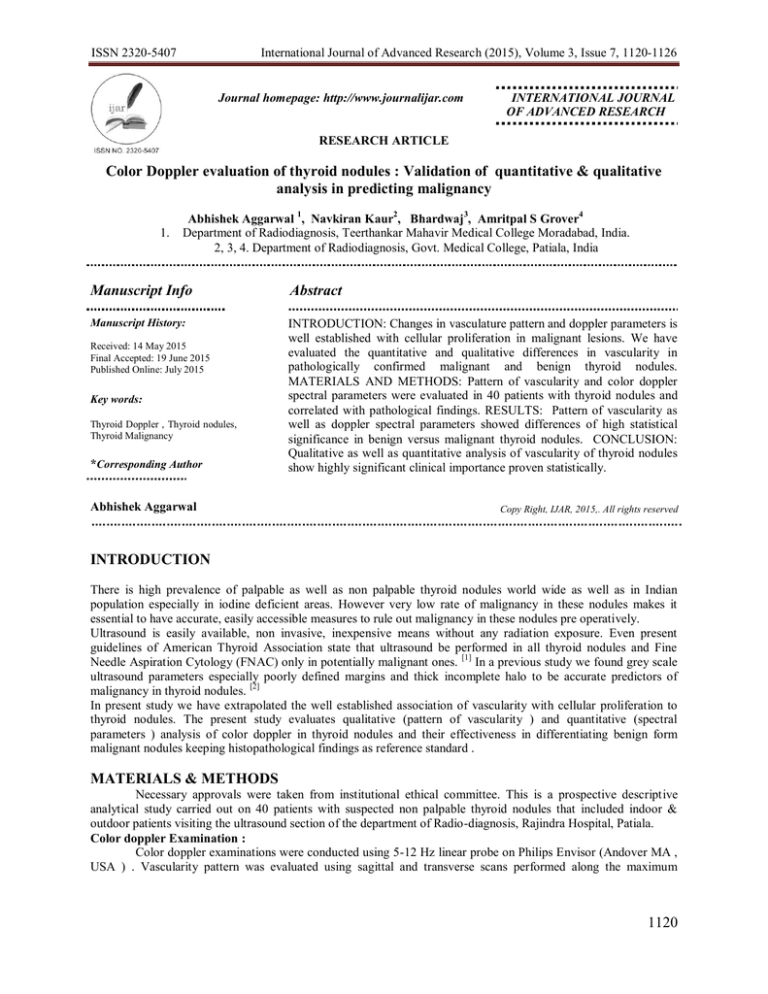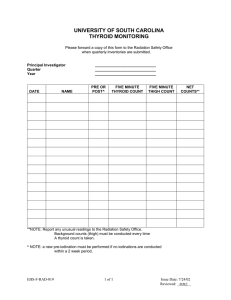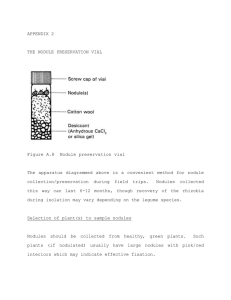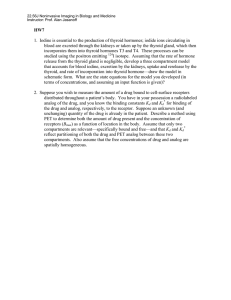
ISSN 2320-5407
International Journal of Advanced Research (2015), Volume 3, Issue 7, 1120-1126
Journal homepage: http://www.journalijar.com
INTERNATIONAL JOURNAL
OF ADVANCED RESEARCH
RESEARCH ARTICLE
Color Doppler evaluation of thyroid nodules : Validation of quantitative & qualitative
analysis in predicting malignancy
1.
Abhishek Aggarwal 1, Navkiran Kaur2, Bhardwaj3, Amritpal S Grover4
Department of Radiodiagnosis, Teerthankar Mahavir Medical College Moradabad, India.
2, 3, 4. Department of Radiodiagnosis, Govt. Medical College, Patiala, India
Manuscript Info
Abstract
Manuscript History:
INTRODUCTION: Changes in vasculature pattern and doppler parameters is
well established with cellular proliferation in malignant lesions. We have
evaluated the quantitative and qualitative differences in vascularity in
pathologically confirmed malignant and benign thyroid nodules.
MATERIALS AND METHODS: Pattern of vascularity and color doppler
spectral parameters were evaluated in 40 patients with thyroid nodules and
correlated with pathological findings. RESULTS: Pattern of vascularity as
well as doppler spectral parameters showed differences of high statistical
significance in benign versus malignant thyroid nodules. CONCLUSION:
Qualitative as well as quantitative analysis of vascularity of thyroid nodules
show highly significant clinical importance proven statistically.
Received: 14 May 2015
Final Accepted: 19 June 2015
Published Online: July 2015
Key words:
Thyroid Doppler , Thyroid nodules,
Thyroid Malignancy
*Corresponding Author
Abhishek Aggarwal
Copy Right, IJAR, 2015,. All rights reserved
INTRODUCTION
There is high prevalence of palpable as well as non palpable thyroid nodules world wide as well as in Indian
population especially in iodine deficient areas. However very low rate of malignancy in these nodules makes it
essential to have accurate, easily accessible measures to rule out malignancy in these nodules pre operatively.
Ultrasound is easily available, non invasive, inexpensive means without any radiation exposure. Even present
guidelines of American Thyroid Association state that ultrasound be performed in all thyroid nodules and Fine
Needle Aspiration Cytology (FNAC) only in potentially malignant ones. [1] In a previous study we found grey scale
ultrasound parameters especially poorly defined margins and thick incomplete halo to be accurate predictors of
malignancy in thyroid nodules. [2]
In present study we have extrapolated the well established association of vascularity with cellular proliferation to
thyroid nodules. The present study evaluates qualitative (pattern of vascularity ) and quantitative (spectral
parameters ) analysis of color doppler in thyroid nodules and their effectiveness in differentiating benign form
malignant nodules keeping histopathological findings as reference standard .
MATERIALS & METHODS
Necessary approvals were taken from institutional ethical committee. This is a prospective descriptive
analytical study carried out on 40 patients with suspected non palpable thyroid nodules that included indoor &
outdoor patients visiting the ultrasound section of the department of Radio-diagnosis, Rajindra Hospital, Patiala.
Color doppler Examination :
Color doppler examinations were conducted using 5-12 Hz linear probe on Philips Envisor (Andover MA ,
USA ) . Vascularity pattern was evaluated using sagittal and transverse scans performed along the maximum
1120
ISSN 2320-5407
International Journal of Advanced Research (2015), Volume 3, Issue 7, 1120-1126
diameter of the nodule. For analyzing pattern of vascularity distribution, we have followed classification proposed
by Chammas et al [3] as follows:
I
Absent Signal Blood Flow
II
Exclusively Perinodular Blood Flow
III
Perinodular Blood flow equal to or greater then intranodular blood flow
IV
Marked intranodular blood flow and less significant perinodular blood Flow
V
Exclusively Intranodular Blood Flow
The amplifier gain settings were set in each case just below the point of appearance of random color noise.
Necessary adjustments were made to pulse repetition frequency, wall filter and sample volume size to optimize flow
imaging and minimize artifacts (PRF:900Hz , wall filter : 50)
The duplex parameters thereafter obtained included pulsatility index [PI] and resistivity index [RI] .The
final value for these parameters was obtained as a mean of three parameters form different arteries. In nodules with
intranodular flow, two of three values were obtained from intranodular vessels.
Values of PI > 1.5 and RI > 0.75 were presumed to be suggestive of malignancy following results of
Chammas et al [3], Holden et al [4]and Cerbone et al [5].
Statistical Examination :
Calculations of accuracy, sensitivity, specificity, and negative and positive predictive values were performed
with the use of a 2 × 2 contingency table. Statistical evaluation was performed using the chi square test, and the
predictivity test of Galen and Gambino. The significance level was always set at a value of p ≤ .05 (5%).
OBSERVATIONS AND RESULTS :
Figure 1: showing type II pattern of vascularity and spectral parameters in a cystic nodule
Figure 2
Figure 2: showing spectral parameters in a nodule having type III pattern of vascularity
1121
ISSN 2320-5407
International Journal of Advanced Research (2015), Volume 3, Issue 7, 1120-1126
Figure 3
Figure 4
Figures 3, 4: showing Type IV vascularity pattern and spectral parameters in a malignant nodule
Figure 5
Figure 5: showing spectral parameters in intranodular vessel in a malignant nodule
1122
ISSN 2320-5407
International Journal of Advanced Research (2015), Volume 3, Issue 7, 1120-1126
TABLE I: SHOWING PATTERN OF VASCULARITY IN THYROID
NODULES (N=40)
Pattern of Vascularity
No. of
Patients
Type I
Absent blood flow
Type II
Exclusively Perinodular
blood flow
Type III
Perinodular blood flow equal to
or greater then intranodular
blood flow
Type IV
Marked intranodular blood flow
and less significant perinodular
blood flow
Type V
Exclusively intranodular
blood flow
Percentage
(%)
1
2.5
7
17.5
22
55
10
25
0
0
TABLE II : SHOWING SPECTRAL INDICES (PI AND RI) OF
THYROID NODULES (39) NODULES
Characteristics
No.
Nodules
of
Percentage
PI
>1.5
10
25
<1.5
29
72.5
>0.75
12
30
<0.75
27
67.5
RI
1123
ISSN 2320-5407
International Journal of Advanced Research (2015), Volume 3, Issue 7, 1120-1126
TABLE III: COLOR DOPPLER FINDINGS IN THYROID NODULES IN CORRELATION WITH
HISTOPATHOLOGICAL FINDINGS (N=39)
Characteristics
Pathological
Diagnosis
Benign(n=31)
Malignant(n=8)
No.
No.
1. Pattern of Vascularity
Type I
Type II
Type III
Type IV
Type V
2Pulsatility Index
>1.5
<1.5
3. Resistivity Index
>0.75
<0.75
%
%
1
7
20
4
0
3.125
21.875
62.5
9.375
0
0
0
2
6
0
0
0
25
75
0
4
27
12.5
84.375
6
2
75
25
5
26
15.625
81.25
7
1
87.5
12.5
TABLE IV: DIAGNOSTIC INDEX FOR INDIVIDUAL COLOR DOPPLER CRITERIA OF THYROID
NODULES
Characteristics
PATTERN
OF
VASCULARITY
SPECTRAL
PARAMETERS
PI
RI
PI +RI
PATTERN
OF
VASCULARITY
+SPECTRAL
PARAMETERS
Sensitivity (%)
Specificity
(%)
PPV
(%)
NPV
(%)
Accuracy
(%)
75
87.5
60
93.33
85
75
87.1
60
93.1
82.5
87.5
83.87
58.33
96.3
82.5
85.71
86.67
60
96.3
80
83.33
93.1
71.43
96.42
80
1124
ISSN 2320-5407
International Journal of Advanced Research (2015), Volume 3, Issue 7, 1120-1126
TABLE V
COLOR DOPPLER FINDINGS IN 40 MALIGNANT AND BENIGN THYROID NODULES (N=40)
Characteristics
1. Pattern of Vascularity
Type I
Type II
Type III
Type IV
Type V
2Pulsatility Index
>1.5
<1.5
Pathological
Diagnosis
Benign(n=31)
Malignant(n=8)
No.
No.
%
p value
%
1
7
20
4
0
3.125
21.875
62.5
9.375
0
0
0
2
6
0
0
0
25
75
0
4
27
12.5
84.375
6
2
75
25
0.003
0.0003
3. Resistivity Index
5
15.625
7
87.5
0.000096
>0.75
26
81.25
1
12.5
<0.75
On statistical analysis, all the three parameters on color Doppler examination were found to be statistically
significant for predicting malignancy in thyroid nodules. PI was found to be having p <0.001 and hence highly
significant while p value for RI was found to be less than 0.0001 and hence very highly significant.
DISCUSSION
Qualitative analysis: probability of malignancy was seen increasing with increase in intranodular blood
flow. This can be attributed to increase in intranodular vascularity with high cellular proliferation in malignancy.
Exclusively intranodular Type V flow was not found in any of the nodules we examined. In our opinion this can be
attributed to the smaller sample size we have taken.
Type I or II pattern of vascularity was not shown by any malignant nodules. Mixed perinodular as well as
intranodular vascularity was present in >70% of benign and 100% of malignant nodules; but this was type IV
(intranodular > perinodular ) in 75 % of malignant nodules and type III (perinodular > intranodular ) in 62% of
benign nodules.
In present study, pattern of vascularity had specificity of 87.5% and positive predictive value (PPV) of 60%,
while sensitivity was 75%, negative predictive value (NPV) was 93.33% and accuracy was 85% for predicting
malignancy.
In study by Papini et al [6] sensitivity and specificity of pattern of vascularity as predictor of malignancy was
74.2% and 80.8% respectively while PPV was 24%. Fukunari et al [7] reported that pattern of vascularity had
specificity of 74.2% and PPV of 46.57%, while sensitivity was 88.9%, NPV value was 95.78% and accuracy was
81%. Chammas et al [3] reported that pattern of vascularity was 97.62% specific for malignancy (PPV-78.57%, NPV
98.4%) with sensitivity of 84.61%
Quantitative analysis: Evaluation of pattern of vascularity can be operator and equipment dependent.
Analysis of quantitative parameters of spectral parameters brings more objectivity in color doppler evaluation.
PI>1.5 for predicting malignancy had specificity of 87.1% and PPV of 60%, while sensitivity was 75%,
NPV was 93.1% with accuracy of 82.5% in present study.
Fukunari et al [7] reported that PI as predictor of malignancy had specificity of 79% while sensitivity was
69.1% and accuracy was 78%. Miyakawa M et al [8] reported that PI was 92% specific for malignancy with
sensitivity of 87.5%
1125
ISSN 2320-5407
International Journal of Advanced Research (2015), Volume 3, Issue 7, 1120-1126
In present study, RI for predicting malignancy had specificity of 83.87% and PPV of 58.33%, while
sensitivity was 87.5%, NPV was 96.3% and accuracy was 82.5%.
De Nicola H et al [9] reported that RI had specificity of 96% and PPV of 62%, while sensitivity was 50%,
NPV was 93% and accuracy was 91%. Chammas et al [3] reported that RI was 88% specific for malignancy with
sensitivity of 92.3%
Introduction of elements of subjectivity and lack of difficulty of reproducibility due to technical parameters
of color doppler was avoided by using parameters as per a pre determined protocol.
CONCLUSION:
Evaluation of pattern of vascularity and pulsed Doppler parameters can predict malignancy in thyroid
nodules sufficiently. Amongst the used quantitative and qualitative parameters, we found RI to be the most useful
parameter showing p value <0.0001 on statistical analysis.
REFERENCES
1.
2.
3.
4.
5.
6.
7.
8.
9.
Cooper DS, Doherty GM, Haugen BR, Kloos RT, Lee SL, Mandel SJ. Revised American Thyroid
Association Management Guidelines for Patients with Thyroid Nodules and Differentiated Thyroid Cancer.
Thyroid 2009;19:1167-214.
Abhishek Aggarwal, Navkiran Kaur, Bhardwaj, Amritpal S Grover. Ultrasound of Thyroid Nodules:
Finding the Best Parameter for Predicting Malignancy. International Journal of Advanced Research 2014;
(9)2: 583-9.
Chammas MC, Gerhard R, de Oliveira IR, Widman A, de Barros N, Durazzo M et al . Thyroid nodules:
evaluation with power Doppler and duplex Doppler ultrasound. Otolaryngol Head Neck Surg. 2005 Jun;
132(6):874-82
Holden A. The role of colour and duplex Doppler ultrasound in the assessment of thyroid nodules.
Australas Radiol 1995; 39:343–9
Cerbone G, Spiezia S, Colao A: Power Doppler improves the diagnostic accuracy of color Doppler
ultrasonography in cold thyroid nodules: follow-up results. Horm Res 1999; 52:19–24.
Papini E, Guglielmi R , Bianchini A, Crescenzi A, Taccogna S, Nardi F et al. Risk of malignancy in
nonpalpable thyroid nodules: predictive value of ultrasound and color-Doppler features. J Clin Endocrinol
Metab 2002; 87:1941-66
Fukunari N, Nagahama M, Sugino K, Mimura T, Ito K . Clinical evaluation of color Doppler imaging for
the differential diagnosis of thyroid follicular lesions.World J Surg. 2004 Dec; 28(12):1261-5.
Miyakawa M, Onoda N, Etoh M, Fukuda I, Takano K, Okamoto T et al. Diagnosis of thyroid follicular
carcinoma by the vascular pattern and velocimetric parameters using high resolution pulsed and power
Doppler ultrasonography. Endocr J. 2005 Apr; 52(2):207-12.
De Nicola H, Szejnfeld J, Logullo AF, Wolosker AM, Souza LR, Chiferi V Jr. Flow pattern and vascular
resistive index as predictors of malignancy risk in thyroid follicular neoplasms. J Ultrasound Med. 2005
Jul;24(7):897-904
1126





